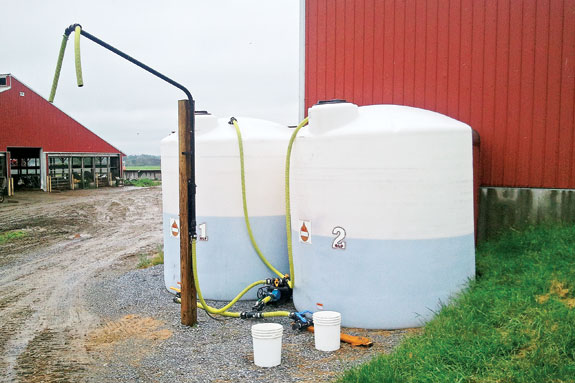Liquid feeds can be a valuable resource for dairy farms to include in their TMRs. Common liquid feeds included in the TMR include water, molasses-based supplements and byproducts such as whey products.
They may be included to increase moisture content of TMRs, improve consistency, reduce sorting or add nutrients. Properly mixing liquids in TMRs is critical to maximizing their benefits.
Not all liquids are the same. Just as not all dry ingredients are mixed the same way, neither are liquid feeds. For example, water may be included at 10 to 20 percent of the TMR, while molasses-based supplements are usually included at 3 to 5 percent of the TMR.
For many dairies it may be useful to add water while the TMR is mixing the customary three to five minutes after all the other ingredients have been added.
My experience is that it probably is better to add molasses-based supplements earlier in the mixing sequence. Using Zn and Mn as markers in one of our molasses supplements, I have seen a more consistent TMR when these supplements were added earlier in the mixing sequence.
For example, in a single vertical screw, one mixing sequence might be: forage, molasses- based supplement, corn, protein sources and forage.
Many producers utilize supermixes (or premixes) to increase mixing accuracy and reduce mixing times. These supermixes include all the concentrates to be used within a day; this supermix is used as one of three or four ingredients in the TMR mixed for the dairy cows.
Molasses-based supplements can be added to the supermix as well. Our experience in the beef industry has shown that it may be a best practice to load the liquid supplement after corn.
For example, in the supermix a farm may load corn, liquid supplement and then other protein/energy sources. The mixer should be mixing vigorously while adding the liquid supplement to eliminate any molasses “balls.”
High-moisture liquids such as whey products should be added with care to the supermix – if left alone in hot weather, these supermixes will likely begin to heat.
Location, location, location. Getting a liquid feed to the right location in the mixer is critical. I see too many setups that assume you can add the liquid anywhere you want and it will mix correctly. Not so.
For dual-screw vertical mixers, the first rule of mixing is to get the liquid equally distributed to both screws. This might include adding the liquid at the center, splitting the source so both sides receive an equal amount of liquid or, in the best-case scenario, engineering a distribution or spray bar that will spread the liquid the length of the mixer.

For other mixers, it may be helpful to add the liquid where feed is actually falling (near the rear in four-screw auger mixers).
The challenge on many farms is how to design a liquid delivery system. Again, not all liquids are created equal. The system you design should account for the type and volume of liquid. For water, a capped three-inch PVC pipe with holes drilled at five and seven inches apart may work well.
However, this setup may not work well for molasses-based supplements on the same farm. Because of the lower volume being delivered, a 1.5-inch PVC pipe may be appropriate.
Be thoughtful on where you set up your system. Does the physical location of the system match your mixing sequence? Do you want the system by the commodity shed or by your forage bunker? If you add a distribution bar, will it interfere with the loading of other ingredients (OK, will it get hit by the payloader)? Does your system account for wind?On some systems we may need to add plastic hoses down into the mixer to prevent issues related to wind.
Weather – In northern climates, in the middle of January, when the wind is howling and the snow is falling, feeders are less likely to be concerned with the perfect spray bar than they are about whether the liquid will flow (i.e. not freeze).
High-moisture liquids like water or whey permeate will likely need heating systems designed for those winter months or they may not be fed at all. Molasses-based supplements are generally higher in DM (50-65 percent) and are less likely to experience problems.
In extreme cold temperatures (below -10ºF), a reversing switch on the liquid pump may be useful in removing excess product from the distribution line.
Quality assurance – The dairy industry has spent a tremendous amount of money to improve milk quality through quality assurance programs. Metrics like SCC, average milking time and milk harvested per hour are used to monitor milking systems. The feed side has hardly begun to implement metrics beyond dry matter intake.
To monitor feed management, farms need to monitor not only DMI but TMR consistency. Monthly evaluations should not only utilize Penn State shaker boxes but minerals assays (as markers) to evaluate TMR consistency. Using moisture, Zn, Mn or salt as markers, we can evaluate how well our dry and liquid feeds are being mixed.
Liquid feeds provide an opportunity on many dairies. They can provide necessary nutrients like sugar and improve ration consistency. To maximize this opportunity, we need to mix liquid feeds correctly, and this process needs to be verified. PD
References omitted due to space but are available upon request. Click here to email an editor.
PHOTO 1: Be thoughtful on where you set up your system. Does the physical location of the system match your mixing sequence? Do you want the system by the commodity shed or by your forage bunker?
PHOTO 2: Not all liquids are the same. Just as not all dry ingredients are mixed the same way, neither are liquid feeds. For example, water may be included at 10 to 20 percent of the TMR, while molasses-based supplements are usually included at 3 to 5 percent of the TMR. Photos Courtesy of Paul Dyk.

-
Paul Dyk
- Dairy Technical Service Manager
- Quality Liquid Feeds
- Email Paul Dyk






